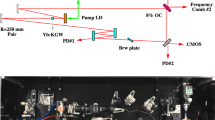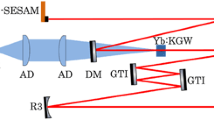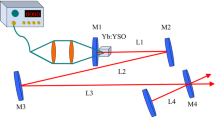Abstract
We have demonstrated a high-power Kerr-lens mode-locked Yb:KGW oscillator with an additional Kerr medium pumped by a high-brightness fiber-coupled diode laser. Operated at the repetition rate of 75.5 MHz, the laser delivers 73 fs pulse duration with average output power of 4.05 W, and the corresponding pulse energy is 53 nJ and the peak power is 0.72 MW, respectively. The output power is recorded to be stable with a fluctuation of less than 0.65% rms within 0.5 h. This work is promising for a variety of applications in nonlinear frequency conversion and high-energy amplifiers.
Similar content being viewed by others
Avoid common mistakes on your manuscript.
1 Introduction
Diode-pumped high-power femtosecond lasers operating at 1 μm are very attractive for many applications, such as medical diagnosis [1], high-field science [2], micro-processing of various materials [3] and nonlinear optics [4]. It is desirable to increase the pulse energy of the output of femtosecond oscillator without amplification. Over the past few years, Yb3+-doped gain media have been regarded as very attractive candidates for diode-pumped solid-state femtosecond oscillators and amplifiers, owning to the large emission and absorption cross-sections, small quantum defect without up-conversion, and high thermal conductivity. Moreover, the simple electronic structure of Yb3+ ion corresponds to an absorption band of 940–980 nm, which matches well with the InGaAs laser diodes and makes it feasible for high-power femtosecond pulses. So, various novel Yb3+-doped gain media, such as Yb:Y3Al5O12 (Yb:YAG), Yb:CaGdAlO4 (Yb:CGA), Yb:CaYAlO4 (Yb:CYA), Yb:KGd(WO4)2 (Yb:KGW), Yb:KY(WO4)2 (Yb:KYW), Yb:LuScO3, Yb:Y2SiO5 (Yb:YSO) and Yb:Gd2SiO5 (Yb:GSO), have been grown and tested to generate femtosecond pulses form mode-locked oscillators [5,6,7,8,9,10,11,12,13,14,15,16,17,18]. Up to now, laser pulses as short as 30 fs were generated from the output of the Yb:CYA oscillator [8]. In 2019, Saltarelli et al. report a new record in average power from a passively mode-locked Yb:YAG thin-disk oscillator, delivering 940 fs pulses with 350 W average power and 40 μJ pulse energy at a repetition rate of 8.8 MHz [19]. Among the Yb3+-doped gain media, Yb:KGW is a popular crystal for high average power, femtosecond laser generation [20]. The broad amplification bandwidth is of the order 25 nm, allowing for the generation of 40 fs duration pulses and even less in the vicinity of 1040 nm. In 2000, Brunner et al. described a passively mode-locked femtosecond laser based on Yb:KGW crystal for the first time, delivering 176 fs pulses with 1.1 W of average output power at center wavelength of 1037 nm [21]. In 2008, Berger et al. demonstrated a high-power femtosecond Yb:KGW oscillator by employing a gain crystal geometry designed for efficient polarized pumping. A pulse duration of 250 fs has been obtained for an average power of 3.5 W centered at 1046 nm [22]. Several years later, Akbari et al. reported on the generation of 240 fs pulse from a Kerr-lens mode-locked Yb:KGW laser. The obtained average output power was 2.3 W. This corresponds to a pulse energy of 26 nJ and a peak power of 97 kW [23]. These typical diode-pumped femtosecond oscillators based on Yb:KGW bulk crystal generate average output power at several W levels. Corresponding pulse energies are between several nJ and several tens nJ, while the pulse durations are more than 100 fs. Thus, operation at high average power with sub-100 fs pulse duration remains considerably challenging. To date, the generation of femtosecond pulses is dominated by the Kerr-lens mode-locking (KLM) lasers because of its broad bandwidth, short pulse duration and relatively stability. KLM is based on a combination of self-focusing in the gain medium and an aperture which selects the spatial mode corresponding to the presence of self-focusing. However, serious thermal effects are introduced in the process of generating femtosecond pulses if the KLM is achieved by the gain medium, which limits the output power and beam quality. The gain material and the Kerr medium can be separated for obtaining higher average power with shorter pulse duration. In 2018, Akbari et al. have demonstrated KLM Yb:KGW oscillator with the help of an additional Kerr medium, delivering 500 mW average output power with 74 fs pulse duration [24]. Utilizing an additional nonlinear medium to enhance the Kerr-lens effects is an attractive method to generate high-power ultrashort femtosecond laser [25].
In this letter, we report a diode-pumped KLM Yb:KGW oscillator with an additional Kerr medium in the form of a 2-mm-long fused silica (FS) plate. By optimizing the design of cavity, the laser produces as high as 4.05 W average output power with 73 fs pulse duration at the repetition rate of 75.5 MHz. This corresponds to a pulse energy of 53 nJ and a peak power of 0.72 MW, respectively. In addition, the long-time power stability of mode-locked laser is better than 0.65% rms within 30 min.
2 Experiment setup
The schematic diagram of experimental setup is shown in Fig. 1. The pump source is a commercial high-brightness fiber-coupled multi transverse mode diode laser (100 μm core diameter, 0.22 NA, M2 ≈ 40) emitting at 980 nm with the maximum power of 40 W. The 1:2 imaging system used focuses the pump beam to a spot size of about 200 μm, which is very close to the cavity mode. A 2-mm-long, Ng-cut Yb:KGW crystal doped with 5 at.% of Yb ion is served as the gain medium, which is coated with high transmittance in 900–1100 nm region. For heat dissipation, the Yb:KGW crystal is wrapped with indium foil and then placed tightly on a water-cooled heat-sink block, where the temperature is maintained at 16 °C. To increase the power density and enhance the Kerr-lens effects, a typical tight focusing Z-shape line cavity is used in the experiment. The DM is a dichroic mirror which is coated with high transmission in the 940–980 nm and high reflection from 1020 nm to 1100 nm. C1, C2, C3 and C4 are concave mirrors with the radius of curvature (ROC) of 500 mm, 300 mm 75 mm and 75 mm, respectively, which are highly reflected in the range of 1020–1100 nm. An additional Kerr medium (FS plate) placed at Brewster’s angle is positioned at the center between C3 and C4. It controls the laser polarization with minimal phase shift introduced by the Brewster plate. The Gires–Tournois interferometer (GTI) mirrors used for this cavity are provided by layertec, with a reflectivity > 99.9% from 1020 to 1070 nm. To obtain high output power, a high transmittance OC should be used in the cavity. However, the OC with high transmittance results a wider pulse in the mode-locking regime because of the weaker self-phase modulation (SPM). To balance the high output power and short pulses, an OC with 2% transmittance mounted on a precise translation stage is chosen in the cavity at last. The total length of cavity is 1.98 m, corresponding to the repetition rate of 75.5 MHz.
3 Experimental results and discussions
We used ABCD matrix to design and simulate the cavity. When using this technique, the precise distances between the various elements can be calculated in the cavity. The cavity determines the beam diameters and intensities at different locations. The cavity design is based on an astigmatically compensated Z-fold cavity, which allows a small spot size and a relative high intensity inside the gain medium and FS plate, as required for the mode-locking regime. Variation of the mode size within the cavity is shown in Fig. 2. The mode size information allow us to determine an appropriate spot size within the Yb:KGW crystal and FS plate. The spot sizes are calculated to be 200 μm and 60 μm at the center of gain medium and FS plate, respectively. In this way, the pump spot and the cavity mode sizes would match well inside the crystal and FS plate.
In preliminary experiments, the oscillator operates in the continuous wave (CW) regime without the aperture. The CW performance of the laser is shown in Fig. 3a. A broadband wavelength tuning range of 56 nm (1008–1064 nm) is achieved with a 2% OC. The broadband and smooth wavelength tuning curve indicates that the Yb:KGW crystal is an excellent candidate to generate ultrashort femtosecond laser pulses. With 22 W of pump power incident on the crystal, the maximum CW output power is as high as 5.8 W at the central wavelength of 1038 nm, resulting in an optical-to-optical efficiency of 24.8%. Like most KLM lasers, the discrimination between a CW regime and a pulsed regime is due to the self-focusing in the gain medium. In our experiment, the original mode locking operates at the edge of the stability region by introducing the aperture (diameter ≈ 1.2 mm) and adjusting the position of the mirror HR. Once the mode-locking regime is established, the Yb:KGW oscillator delivers stable pulse trains with output power increasing to 4.05 W for available pump power of 22 W, corresponding to efficiency of 18.4%. This contributes to a pulse energy of 53 nJ and a peak power of 0.72 MW at repetition rate of 75.5 MHz. Figure 3b shows the mode-locking output powers versus different incident pump powers. By further increasing pump power to more than 22 W, the multi-pulse operation has been observed because of the peak limiting and soliton quantization effect. The single pulse breaks up three solitons that co-exist with non-uniform intensity distribution. Due to the gain competition effect, these solitons modulate their relative strengths so that the stronger ones become weaker because of the soliton energy quantization effect. Similarly, the weaker ones become stronger, eventually, leading to the state of stable ordered multi-solitons [26].
For most femtosecond solid-state lasers, oscillators usually operate in the net negative cavity dispersion region in which the mutual nonlinear interaction between the SPM and negative cavity dispersion leads to the mode-locked pulse to be shaped into nonlinear Schrödinger equation (NLSE)-type solitons [27]. Limited by the soliton area theorem, it is difficult to achieve large energy mode-locked pulses. Compared to NLSE solitons, dissipative solitons formation depends on the nonlinear interplay among the positive cavity dispersion, SPM, saturated gain and effective gain bandwidth filtering. Dissipative solitons are strongly chirped pulses and have larger pulse energy [28]. To obtain near Fourier transform limited pulse duration, it is necessary to balance the SPM, intracavity dispersion, saturated gain and loss and nonlinear phase shift. SPM is generated by the pulses through nonlinear materials, including the Yb:KGW, air and FS plate. It can be adjusted by changing the position and thickness of the Kerr medium. The dispersion compensation is achieved by introducing GTI mirrors. A pair of GTI mirrors with group delay dispersion (GDD) of approximately − 1300 ± 150 fs2 per bounce in the 1040–1080 nm range are used to compensate the dispersion. One more GTI mirror is inserted as a folding mirror in the short arm, contributing a further GDD of − 1000 ± 100 fs2 to provide enough negative dispersion to the cavity. The estimated total round-trip cavity dispersion is approximately − 12,400 ± 1400 fs2. The corresponded total intracavity GDD is negative dispersion and close to zero. The intensity autocorrelation trace measured at 4.05 W output power is shown in Fig. 4, which indicates pulse duration of 73 fs assuming a sech2-shape fit. As shown in the inset of this figure, the corresponding spectrum is measured using an optical spectrum analyzer with ~ 0.5 nm resolution. The spectral width is 22.5 nm full width at half maxima (FWHM) at center wavelength of 1045 nm, and the corresponding Fourier transform limited duration is 51 fs. These two measurements indicate that the time–bandwidth product is ~ 0.451, which is 1.43 times large than the Fourier transform limited value assuming a sech2 pulse shape, implying a small amount of chirp is present.
The radio frequency (RF) of the mode-locked pulses is measured by a commercial RF spectrum analyzer with a photodiode. Figure 5a shows the fundamental beat note at 75.5 MHz with an extinction rate down to 72 dB with a resolution bandwidth of 1 kHz, which indicates a stable mode-locked operation. The high harmonics of the fundamental beat note at a wide span from 0 to 1 GHz is shown as an inset in Fig. 5a with a resolution bandwidth of 100 kHz. Without any feedback control of the cavity length, we measured the phase noise of this KLM Yb:KGW oscillator, as shown in Fig. 5b. By calculating the integrated phase noise, we find that almost all the fluctuations of repetition rate are located at the frequency over the range of 1–10 Hz. These noises are mainly caused by air disturbance, vibration and temperature drift. Considering that oscillator is currently built directly on the optical table without any housing, we believe that the noises would be much lower with good housing and feedback control of the cavity length.
To describe the stability of the mode-locking operation, we measured the beam quality and long-time stability of the average output power of the Yb:KGW oscillator. The spatial profile and beam quality of the laser beam in high-power output (4.05 W) situation is shown in Fig. 6a. The M2 factor with maximum output power is measured using a commercial M2 factor meter (Spiricon M2-200 s), resulting in the horizontal and vertical directions of 1.18 and 1.12, respectively. The beam spatial profile is also measured with a charge-coupled device (CCD) camera, which exhibits a Gaussian shape to a good approximation. As shown in the Fig. 6b, the root-mean-square (RMS) of power fluctuation is 0.65% within 0.5 h at 4.05 W maximum output power. The fluctuations of output power are due to air flow, environmental vibration and temperature drift. The power stability can be further improved using feedback control system in which the pump power and direction are adjusted to maintain the laser operation.
4 Conclusion
In summary, we have demonstrated a high-power KLM Yb:KGW oscillator pumped by a high-brightness fiber-coupled diode laser. Under the pump power of 22 W, the maximum output power is 4.05 W using a 2% OC, while the corresponding pulse energy and peak power are 53 nJ and 0.72 MW, respectively. Operated at 75.5 MHz repetition rate, the oscillator delivers 73 fs pulse duration centered at 1045 nm. The oscillator results in excellent long-term power stability better than 0.65% rms within 0.5 h. We believed that sub-100 fs pulses at W-level average power femtosecond oscillator could be applied in many applications including nonlinear optics and high-energy amplifiers.
References
G. Hüttmann, C. Yao, E. Endl, Med Laser Appl 20, 2 (2005)
T. Südmeyer, S.V. Marchese, S. Hashimoto, C.R.E. Baer, G. Gingras, B. Witzel, U. Keller, Nat. Photonics 2, 10 (2008)
K.M.T. Ahmmed, C. Grambow, A. Kietzig, Micromachines 5, 4 (2014)
T. Brabec, F. Krausz, Rev. Mod. Phys. 72, 545 (2000)
M. Kowalczyk, A. Major, J. Sotor, Opt. Express 22, 25 (2017)
R. Akbari, K.A. Fedorova, E.U. Rafailov, A. Major, Appl. Phys. B 123, 123 (2017)
G.Q. Xie, D.Y. Tang, L.M. Zhao, L.J. Qian, K. Ueda, Opt. Lett. 32, 18 (2007)
J. Ma, H. Huang, K. Ning, X. Xu, G. Xie, L. Qian, K.P. Loh, D. Tang, Opt. Lett. 41, 5 (2016)
J. Brons, V. Pervak, E. Fedulova, D. Bauer, D. Sutter, V. Kalashnikov, A. Apolonskiy, O. Pronin, F. Krausz, Opt. Lett. 39, 22 (2014)
P. Sévillano, P. Georges, F. Druon, D. Descamps, E. Cormier, Opt. Lett. 39, 20 (2014)
M. Jacquemet, C. Jacquemet, N. Janel, F. Druon, F. Balembois, P. Georges, J. Petit, B. Viana, D. Vivien, B. Ferrand, Appl. Phys. B 80, 171 (2005)
V.E. Kisel, A.S. Rudenkov, A.A. Pavlyuk, A.A. Kovalyov, V.V. Preobrazhenskii, M.A. Putyato, N.N. Rubtsova, B.R. Semyagin, N.V. Kuleshov, Opt. Lett. 40, 12 (2015)
F. Pirzio, S.D. Di Dio-Cafiso, M. Kemnitzer, F. Kienle, A. Guandalini, J. Ausder-Au, A. Agnesi, J. Opt. Soc. Am. B 32, 11 (2015)
M. Tokurakawa, A. Shirakawa, K. Ueda, H. Yagi, M. Noriyuki, T. Yanagitani, A.A. Kaminskii, Opt. Express 17, 5 (2009)
F. Thibault, D. Pelenc, F. Druon, Y. Zaouter, M. Jacquemet, P. Georges, Opt. Lett. 31, 10 (2006)
S. Kitajima, H. Nakao, A. Shirakawa, H. Yagi, T. Yanagitani, Opt. Lett. 41, 19 (2016)
J. Zhang, J. Brons, N. Lilienfein, E. Fedulova, V. Pervak, D. Bauer, D. Sutter, Z. Wei, A. Apolonski, O. Pronin, F. Krausz, Opt. Lett. 40, 8 (2015)
H. Zhao, A. Major, Opt. Express 21, 26 (2013)
F. Saltarelli, I.J. Graumann, L. Lang, D. Bauer, C.R. Phillips, U. Keller. In: Conference on lasers and electro-optics (CLEO). IEEE, pp 1–2 (2019)
N.V. Kuleshov, A.A. Lagatsky, A.V. Podlipensky, V.P. Mikhailov, Opt. Lett. 22, 17 (1997)
F. Brunner, G.J. Spühler, J. Aus der Au, L. Krainer, F. Morier-Genoud, R. Paschotta, N. Lichtenstein, S. Weiss, C. Harder, A.A. Lagatsky, A. Abdolvand, N.V. Kuleshov, U. Keller, Opt. Lett. 25, 15 (2000)
J.A. Berger, M.J. Greco, W.A. Schroeder, Opt. Express 16, 12 (2008)
R. Akbari, A. Major, Appl. Opt. 56, 31 (2017)
R. Akbari, A. Major, Laser Phys. Lett. 15, 085001 (2018)
W. Tian, Y. Peng, Z. Zhang, Z. Yu, J. Zhu, X. Xu, Z. Wei, Photon. Res. 6, 2 (2018)
Y. Chen, M. Wu, P. Tang, S. Chen, J. Du, G. Jiang, Y. Li, C. Zhao, H. Zhang, S. Wen, Laser Phys. Lett. 11, 055101 (2014)
W.D. Tan, D.Y. Tang, C.W. Xu, J. Zhang, X.D. Xu, D.Z. Li, J. Xu, Opt. Express 19, 19 (2011)
J. Ma, J. Wang, D. Shen, H. Yu, H. Zhang, D. Tang, Opt. Express 23, 25 (2015)
Acknowledgements
We are grateful for the funding provided by the National Natural Science Foundation of China (Grant Nos. 11504433, 11775312).
Author information
Authors and Affiliations
Corresponding authors
Additional information
Publisher's Note
Springer Nature remains neutral with regard to jurisdictional claims in published maps and institutional affiliations.
Rights and permissions
About this article
Cite this article
Meng, X., lv, C., Liu, Q. et al. Diode-pumped Yb:KGW laser with 73 fs pulse and 0.72 MW peak power based on Kerr-lens mode locking. Appl. Phys. B 125, 166 (2019). https://doi.org/10.1007/s00340-019-7281-1
Received:
Accepted:
Published:
DOI: https://doi.org/10.1007/s00340-019-7281-1










